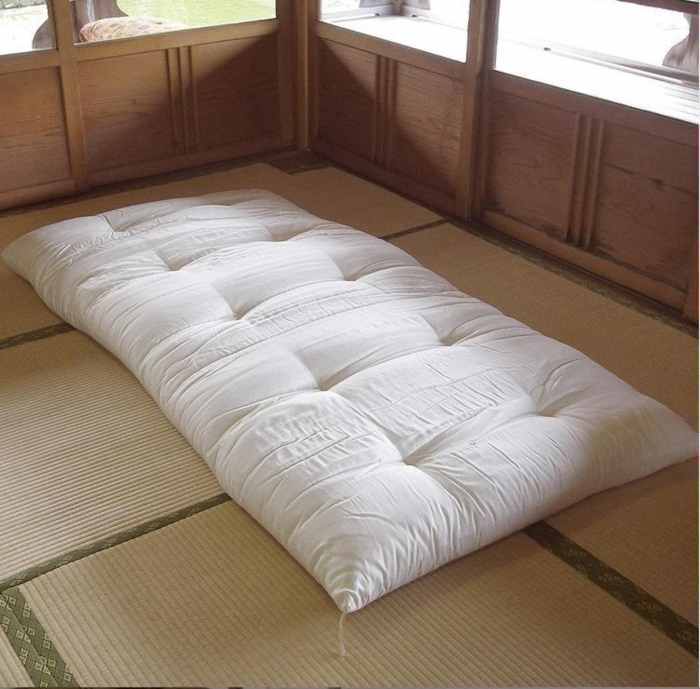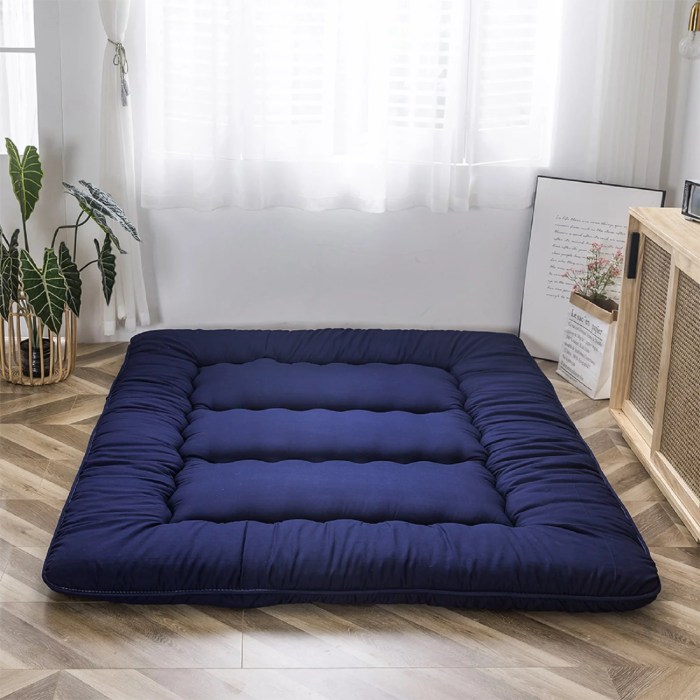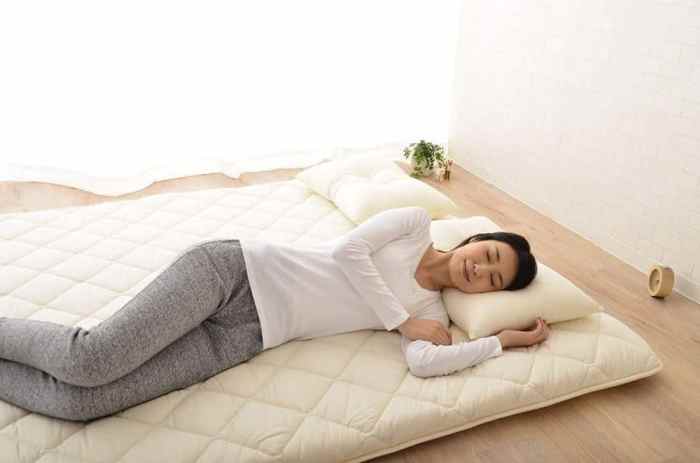Japanese floor mattresses, also known as tatami, have a rich history and cultural significance in Japan. These versatile and comfortable mats are gaining popularity worldwide for their unique benefits and aesthetic appeal. This comprehensive guide explores the fascinating world of Japanese floor mattresses, from their origins to their modern adaptations.
Discover the different types of Japanese floor mattresses, their unique characteristics, and how they can enhance your home décor and well-being. Dive into the materials and construction methods used to create these exquisite mats, ensuring durability and longevity. Learn the proper care and maintenance techniques to extend the lifespan of your Japanese floor mattress.
Japanese Floor Mattress History

Japanese floor mattresses, known as futons, have a rich history dating back centuries. Originating in ancient Japan, futons were originally simple mats made of rice straw or cotton and used as bedding on tatami mats.
Over time, futons evolved in design and construction. During the Edo period (1603-1868), cotton-stuffed futons became popular among the wealthy, while straw-stuffed futons remained common among the lower classes.
Types of Japanese Floor Mattresses
Today, there are several types of Japanese floor mattresses available, each with its unique characteristics:
- Traditional Futons: These are thick, quilted mattresses filled with cotton or a blend of cotton and polyester. They are known for their comfort and durability.
- Roll-Up Futons: These are thin, lightweight futons that can be easily rolled up and stored when not in use. They are ideal for small spaces or occasional use.
- Tatami Futons: These are futons designed to be placed on top of tatami mats. They are typically thinner and firmer than traditional futons.
Benefits and Uses of Japanese Floor Mattresses
Japanese floor mattresses offer numerous benefits, contributing to improved well-being and versatile home decor. They promote better posture, enhance sleep quality, and optimize space utilization.
These mattresses are commonly used in bedrooms as a comfortable and space-saving sleeping solution. In living rooms, they serve as cozy seating areas for relaxation and entertainment. Additionally, they are a convenient option for guest rooms, providing a comfortable and welcoming place for visitors.
A japanese floor mattress is an incredibly versatile sleeping surface, offering both comfort and support. If you’re looking to enhance its plushness even further, consider adding a mattress topper . These toppers come in a variety of materials and thicknesses, allowing you to customize your sleeping experience.
With a mattress topper, you can enjoy the benefits of a japanese floor mattress while experiencing an extra layer of comfort and support.
Space-Saving and Adaptability
Japanese floor mattresses are renowned for their space-saving design. Their compact size makes them ideal for small apartments or rooms where space is limited. They can be easily stored away when not in use, allowing for flexible use of the space.
Materials and Construction of Japanese Floor Mattresses
Japanese floor mattresses, known as tatami or futon, are traditionally made from natural materials such as cotton, buckwheat, and straw. The construction methods and techniques used to create these mattresses have been refined over centuries, resulting in a durable and comfortable sleeping surface.
Materials
- Cotton:Soft and breathable, cotton is a popular choice for futon mattresses. It provides a comfortable sleeping surface and can be used in all seasons.
- Buckwheat:Buckwheat hulls are used to fill traditional tatami mattresses. They conform to the body’s shape, providing excellent support and breathability.
- Foam:Modern futon mattresses often incorporate foam layers for added comfort and support. Foam can range in firmness from soft to firm, allowing for customization.
Construction
Japanese floor mattresses are typically constructed using traditional methods that involve hand-tufting or stitching. The materials are carefully layered and secured to create a durable and supportive mattress. The edges of the mattress are often reinforced with fabric or stitching to prevent wear and tear.
Care and Maintenance of Japanese Floor Mattresses

Preserving the quality of Japanese floor mattresses is crucial for their longevity and comfort. Regular care and maintenance practices, such as cleaning, airing, and proper storage, contribute to their lifespan and prevent deterioration.
Japanese floor mattresses, renowned for their comfort and versatility, offer an unparalleled seating experience. For added support and customization, consider incorporating a floor cushion into your seating arrangement. These cushions enhance comfort and create a personalized seating area, complementing the traditional Japanese floor mattress experience.
Cleaning
- Vacuuming:Regularly vacuum the mattress to remove dust and debris from the surface.
- Spot cleaning:For spills or stains, use a damp cloth with mild detergent to gently wipe the affected area. Avoid using harsh chemicals or excessive moisture.
- Professional cleaning:If the mattress becomes heavily soiled or stained, consider professional cleaning services to ensure thorough sanitization and restoration.
Airing, Japanese floor mattress
Regular airing promotes ventilation and prevents moisture buildup, which can lead to mold or mildew. Air the mattress by:
- Opening windows:Open windows or doors in the room where the mattress is located to allow fresh air to circulate.
- Sun exposure:Expose the mattress to indirect sunlight for a few hours to kill bacteria and refresh the fibers.
- Using a fan:Place a fan near the mattress to promote air movement and prevent moisture accumulation.
Storage
When not in use, store the mattress in a dry, well-ventilated area to prevent moisture damage and dust accumulation. Consider using a mattress bag or cover for additional protection.
Modern Adaptations of Japanese Floor Mattresses
Japanese floor mattresses have evolved to meet contemporary lifestyles and preferences, resulting in innovative adaptations that seamlessly blend traditional craftsmanship with modern functionality and aesthetics. These adaptations include futons, sofa beds, and hybrid mattresses, each offering unique advantages and cater to different needs.
Futons
Futons, a modern adaptation of the traditional Japanese shikibuton, are versatile and space-saving. They consist of a thick, foldable mattress filled with cotton, foam, or other materials. Futons can be easily rolled up and stored during the day, freeing up floor space.
For a touch of Eastern tradition, consider a Japanese floor mattress. Its firm support and breathable materials provide a restful night’s sleep. For those accustomed to sleeping on the floor, sleeping mattress on floor options offer a comfortable alternative to traditional mattresses.
Japanese floor mattresses, with their low profile and versatility, seamlessly integrate into any bedroom décor, adding a touch of minimalist elegance to your sleeping space.
When needed, they can be unrolled to create a comfortable sleeping surface.
Sofa Beds
Sofa beds combine the functionality of a sofa and a bed in one piece of furniture. They feature a comfortable sofa that can be easily converted into a bed by extending the seat or backrest. Sofa beds are ideal for small spaces or guest rooms, providing both seating and sleeping arrangements.
Hybrid Mattresses
Hybrid mattresses blend the comfort of traditional Japanese floor mattresses with the support and durability of modern mattresses. They typically feature a base layer made of foam or coils, topped with a layer of natural materials such as cotton, wool, or latex.
Hybrid mattresses offer a balance of softness and support, catering to those who prefer a firmer sleeping surface.
Concluding Remarks

In conclusion, Japanese floor mattresses offer a harmonious blend of tradition and modernity, providing both comfort and style. Whether you seek to improve your posture, enhance your sleep quality, or add a touch of Japanese aesthetics to your home, a Japanese floor mattress is an exceptional choice.
Embrace the timeless charm and versatility of these remarkable mats and experience the tranquility and comfort they bring.
Helpful Answers
What are the benefits of using Japanese floor mattresses?
Japanese floor mattresses provide numerous benefits, including improved posture, better sleep quality, space-saving, and enhanced comfort.
How do I care for my Japanese floor mattress?
Regular cleaning, airing, and proper storage are crucial for maintaining the longevity of your Japanese floor mattress. Avoid excessive moisture and direct sunlight.
What are the different types of Japanese floor mattresses?
Japanese floor mattresses come in various types, including traditional tatami mats made from woven rush grass, futons filled with cotton or foam, and modern hybrid mattresses that combine traditional and contemporary materials.